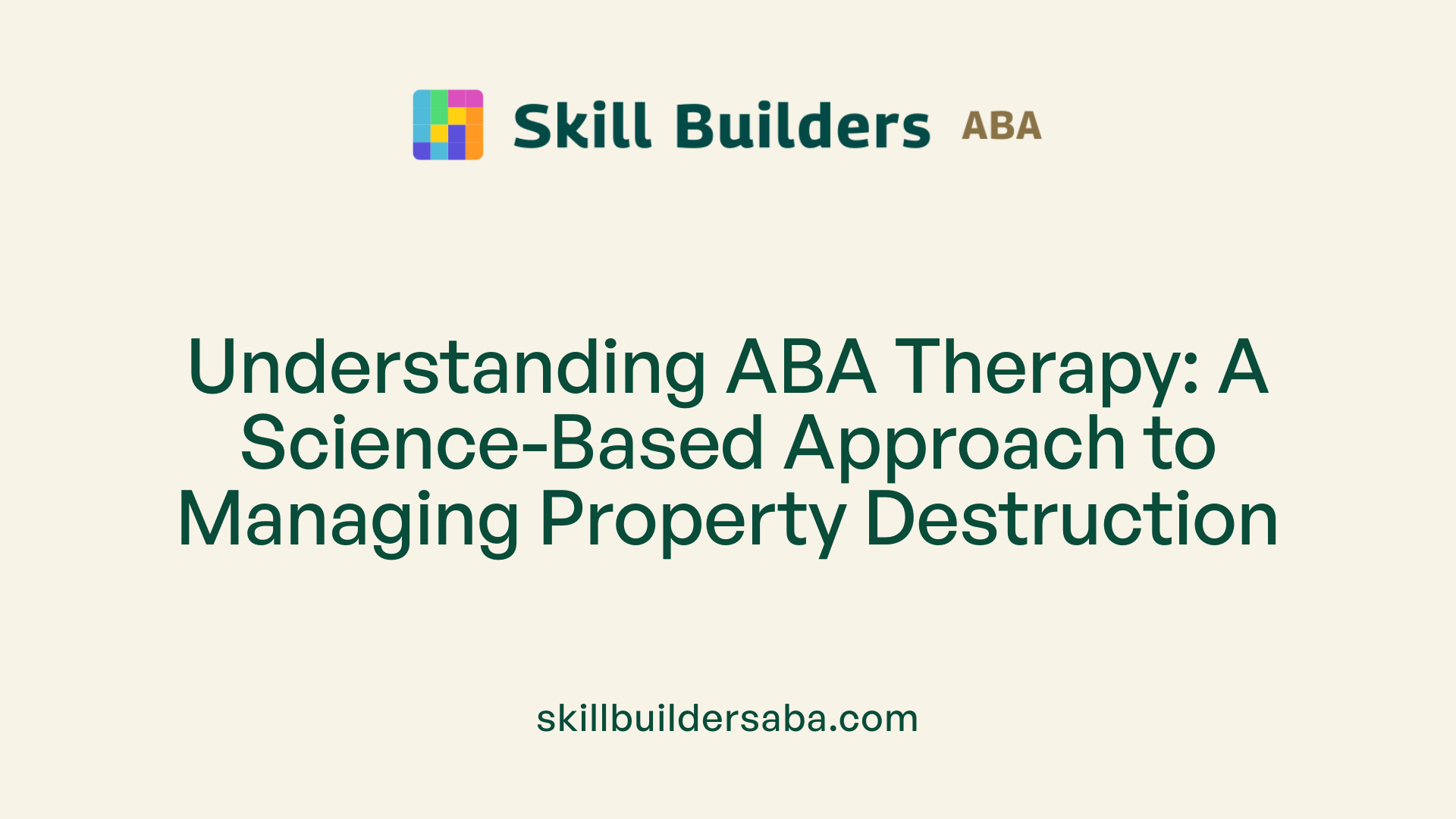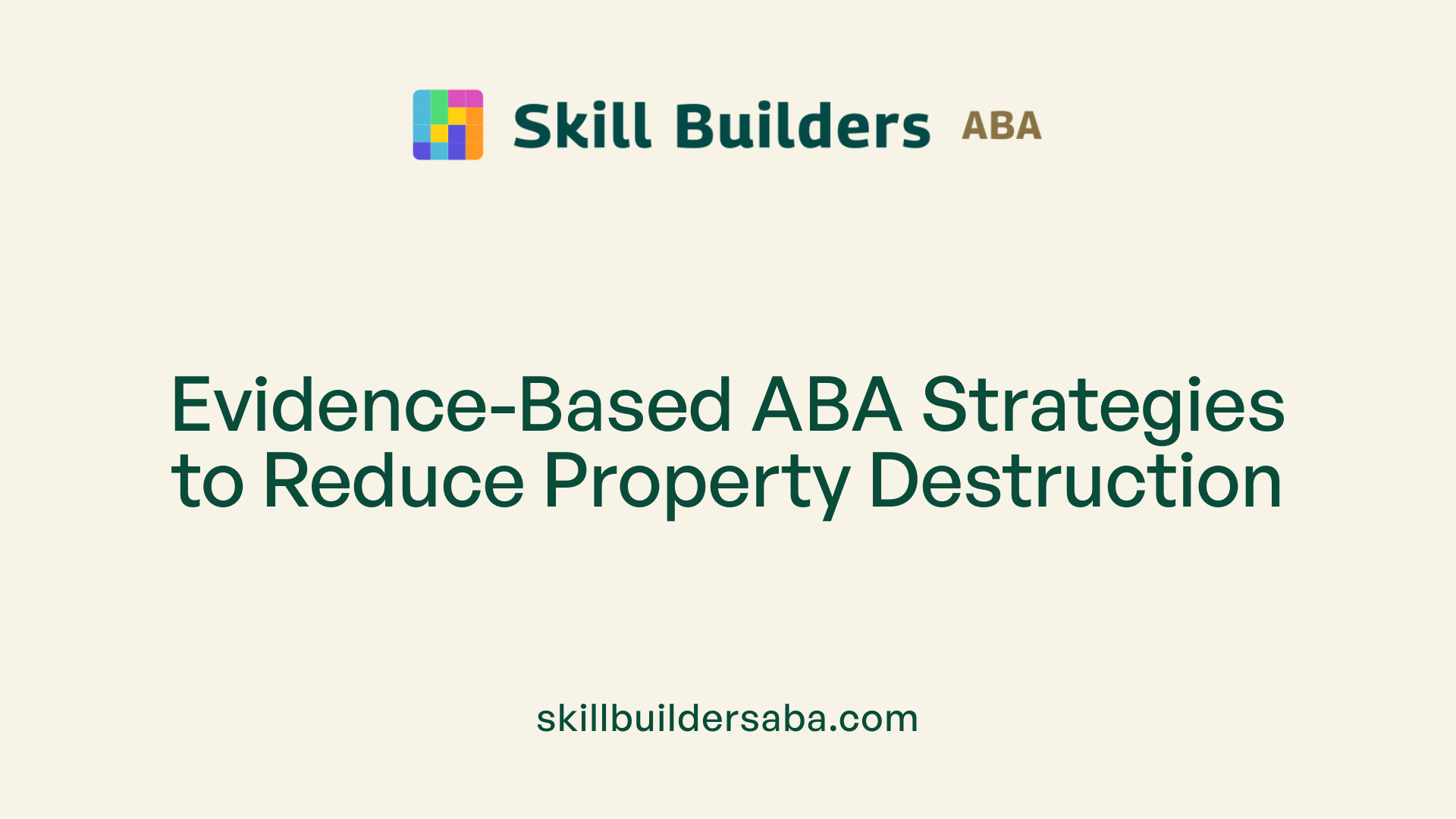
ABA approaches to reduce property destruction
Innovative ABA Strategies to Curb Property Destruction in Autism
Understanding Property Destruction in Autism Through ABA
Property destruction is a challenging behavior commonly observed in individuals with autism spectrum disorder (ASD). Often misunderstood as mere misbehavior, such actions frequently serve as a form of communication or responses to environmental stressors such as frustration or sensory overload. Applied Behavior Analysis (ABA) therapy offers evidence-based approaches to effectively address and reduce property destruction by identifying its underlying functions and implementing customized interventions. This article explores how ABA principles are applied to understand, assess, and treat property destruction while supporting meaningful behavior change in individuals with autism.
What is ABA Therapy and Its Role in Addressing Property Destruction?

Definition of ABA Therapy
Applied Behavior Analysis (ABA) therapy is a science-based approach that uses behavioral principles to support individuals with autism. It focuses on increasing beneficial skills such as social interaction and communication while decreasing problematic behaviors.
How ABA Analyzes Behavior Triggers
ABA uses the Antecedent-Behavior-Consequence (ABC) model and functional behavioral assessments (FBA) to identify environmental triggers and consequences maintaining behaviors like property destruction. Functional analysis, a core ABA procedure, systematically examines these triggers to understand the purpose behind challenging behaviors.
Use of ABA for Behavior Modification
ABA employs various strategies such as extinction, differential reinforcement of alternative behavior (DRA), functional communication training (FCT), and antecedent manipulations to reduce problem behaviors and encourage adaptive skills. For example, teaching alternative communication helps reduce destructive behaviors that often serve as communication forms.
Individualization of ABA Treatment Plans
Each ABA program is tailored based on assessment outcomes, ensuring interventions address the specific causes of behavior. Data collected during therapy sessions guide ongoing adjustments, promoting effective, personalized treatment for individuals with autism.
ABA's Evidence Base
ABA has a strong research foundation, including randomized controlled trials and meta-analyses, showing substantial reductions in problem behaviors—often exceeding 75%—including property destruction. This evidence supports ABA as an effective, individualized method for managing challenging behaviors linked to autism.
Types of Behavioral Challenges in Autism Addressed by ABA

What types of behavioral challenges in autism can ABA therapy address effectively?
ABA therapy effectively addresses a broad spectrum of behavioral challenges associated with autism spectrum disorder (ASD). These challenges include communication difficulties, social skill deficits, repetitive behaviors, and several types of harmful behaviors such as aggression, self-injury, elopement, and property destruction.
Range of behavioral challenges
Problem behaviors in autism often function as ways to gain attention, access tangibles, escape or avoid unpleasant situations, or fulfill sensory needs. ABA interventions focus on understanding the specific causes behind these behaviors through functional behavioral assessments (FBA) and functional analyses (FA). This individualized approach enables therapists to tailor interventions that reduce problematic behaviors while promoting more functional and adaptive responses.
Specifics on property destruction
Property destruction is a common challenge where children may damage objects due to frustration, sensory overload, or communication barriers. Importantly, such behavior is often a form of communication rather than mere misbehavior. Through ABA, these behaviors are assessed objectively to identify their function and managed through proactive and reactive strategies that emphasize empathy and understanding.
Functions of problem behaviors
Challenging behaviors serve different functions including seeking attention, obtaining items, avoiding tasks, or sensory reinforcement. By identifying these functions, ABA practitioners develop tailored interventions that often combine extinction (removal of reinforcement), functional communication training (FCT), and differential reinforcement strategies. These procedures help replace problematic behaviors with more appropriate alternatives.
Aggression, self-injury, elopement
Behaviors such as aggression, self-injury, and elopement are particularly serious and are often addressed in ABA programs that emphasize safety and skill-building. Interventions may include teaching functional communication to express needs safely, implementing safety protocols, and using evidence-based techniques like noncontingent reinforcement and response blocking to reduce these behaviors.
Adaptive skill development
Alongside reducing challenging behaviors, ABA fosters adaptive skill development. This includes teaching daily living skills, coping mechanisms, and social communication skills through positive reinforcement. Such an emphasis ensures that individuals not only reduce problematic behaviors but also acquire meaningful skills that enhance independence and quality of life.
Overall, ABA offers a comprehensive and evidence-based framework that not only addresses challenging behaviors rooted in autism but also strengthens adaptive behaviors for greater social inclusion and personal well-being.
Understanding the Function of Property Destruction through Functional Behavioral Assessment (FBA)

Role of FBA in Identifying Behavior Functions
Functional Behavioral Assessment (FBA) plays a central role in pinpointing the reasons behind property destruction, especially in children with autism. By carefully examining the antecedents (what happens before the behavior) and consequences (what happens after), FBA helps professionals understand the environmental triggers and reinforcers that maintain such behavior.
Environmental Antecedents and Consequences
Property destruction often results from frustration, sensory overload, or challenges in communication. FBA identifies these environmental antecedents and consequences that influence the behavior, such as attention from caregivers, escape from demands, or sensory stimulation that inadvertently reinforces destructive acts.
How FBA Guides Intervention
With insights gained from FBA, individualized interventions can be designed that address the specific function of property destruction. These interventions often include teaching alternative communication strategies, modifying the environment to reduce triggers, and using reinforcement techniques tailored to what motivates the individual.
Comparison with Functional Analysis (FA)
While FBA broadly gathers information on behavior-environment relationships, Functional Analysis (FA) offers a more experimental approach by systematically exposing the individual to different contingencies suspected to maintain the behavior. FA can empirically confirm the function of property destruction and strengthen the basis for targeted treatment.
Importance of Function-Based Treatment
Treatments derived from function-based assessments like FBA and FA have shown remarkable effectiveness, often reducing destructive behaviors by 75% to 100%. Understanding the purpose behind property destruction ensures interventions are compassionate and effective, focusing on communication and fulfilling needs rather than punishment.
Empirically Supported ABA Procedures for Reducing Property Destruction

What ABA Techniques Are Used to Address Property Destruction?
Applied Behavior Analysis (ABA) employs several evidence-based techniques to reduce property destruction, a common challenge in children with autism. Techniques like extinction, non-contingent reinforcement (NCR), differential reinforcement of alternative behavior (DRA), and functional communication training (FCT) are central. Extinction removes reinforcement for property destruction, discouraging the behavior. NCR provides reinforcement independently of behavior to reduce motivation for destructive acts. DRA encourages replacing destructive behaviors with alternative, appropriate responses. FCT teaches individuals to communicate their needs effectively, lessening frustration that can lead to property damage.
How Are Response Blocking, Timeout, and Punishment Used?
Response blocking physically prevents the individual from carrying out property destruction, interrupting the behavior directly. Timeout from reinforcement involves temporarily removing access to preferred stimuli following destruction, reducing the likelihood it recurs. Punishment procedures, while used sparingly, serve to decrease destructive behavior by introducing aversive consequences. Each method is selected carefully based on the behavior's function and balanced with positive interventions.
How Do ABA Procedures Align With Behavior Functions?
ABA interventions are tailored through Functional Behavioral Assessment (FBA) and functional analysis to identify why property destruction occurs—whether to gain attention, escape demands, or obtain sensory stimulation. Treatments based on these functions, such as teaching communication through FCT for escape or attention-seeking behaviors or providing competing stimuli for automatic reinforcement, are more effective. This function-based approach ensures interventions precisely target the underlying cause rather than just the behavior's form.
How Are Proactive and Reactive Strategies Balanced?
ABA blends proactive strategies—like consistent routines, visual supports, and teaching coping and communication skills—with reactive strategies, such as calmly redirecting behavior, providing immediate feedback, and employing response blocking. Proactive measures reduce triggers for property destruction, while reactive responses manage behaviors safely when they arise, ensuring a comprehensive and compassionate intervention.
What Evidence Supports These Procedures?
Numerous rigorous studies, including randomized controlled trials, meta-analyses, and systematic reviews, affirm the effectiveness of these ABA procedures. Treatments informed by functional assessments often achieve dramatic reductions in destructive behaviors, frequently surpassing 75-100% improvement. This evidence base substantiates the use of these strategies as integral components of behavior management in autism.
| ABA Procedure | Function Targeted | Description & Role |
|---|---|---|
| Extinction | All functions | Withholds reinforcement for property destruction to reduce behavior |
| Non-contingent Reinforcement (NCR) | Escape, attention | Provides reinforcement independently to reduce motivation for behavior |
| Differential Reinforcement of Alternative Behavior (DRA) | Escape, attention | Reinforces alternative, appropriate behaviors |
| Functional Communication Training (FCT) | Escape, attention | Teaches communication to replace destructive behavior |
| Response Blocking | Immediate prevention | Physically interrupts destructive acts |
| Timeout from Reinforcement | Escape, attention | Temporarily removes reinforcers following behavior |
| Punishment Procedures | When necessary | Introduces aversive consequences to reduce behavior |
Prevention and Replacement Strategies in Managing Property Destruction

What preventive techniques can help manage property destruction?
Preventing property destruction involves proactive strategies such as using visual schedules, timers, countdowns, priming, and social stories. These tools help create consistent routines and reduce anxiety by providing clear expectations. Behavioral antecedent manipulations—like noncontingent escape, demand fading, and offering choices—make the environment less aversive and more engaging, reducing triggers for destructive behavior.
How are coping and communication skills taught as replacement strategies?
Teaching coping skills and functional communication serves as effective replacement strategies. For example, individuals learn ways to express their needs or frustrations appropriately, decreasing the likelihood of property destruction arising from communication difficulties or sensory overload. Techniques include training daily living skills and alternative behaviors that fulfill the same function as the challenging behavior.
How does Functional Communication Training (FCT) support behavior change?
FCT is an empirically supported ABA procedure that teaches alternative communication methods to replace problem behaviors. By instructing individuals to request breaks or changes in activities verbally or through systems like picture exchange, FCT reduces escape-motivated destructive behaviors, aligning treatment with the function of the behavior.
What role do antecedent manipulations and stimulus preference play?
Antecedent manipulations aim to modify environmental factors responsible for triggering problem behaviors. Stimulus preference assessments identify reinforcing stimuli that can be used to compete with or replace property destruction. Incorporating preferred activities or items before problem behaviors occur helps redirect attention and improve engagement.
How are replacement behaviors developed as adaptive alternatives?
Replacement behaviors are carefully selected adaptive skills that serve the same function as the problem behavior, such as requesting help instead of breaking objects. These behaviors are reinforced through positive reinforcement strategies, ensuring motivation and maintenance. Teaching these alternatives helps individuals gain control over their environment in socially acceptable ways, fostering generalization across settings.
| Strategy | Description | Purpose |
|---|---|---|
| Visual Schedules & Timers | Structured cues for activities and transitions | Prevent anxiety and unpredictability |
| Functional Communication Training (FCT) | Teaching alternative ways to communicate | Reduce behaviors stemming from communication challenges |
| Antecedent Manipulations | Environmental changes like demand fading | Lower triggers for destructive behaviors |
| Stimulus Preference Assessments | Identify reinforcers to compete with negative behaviors | Increase engagement with positive stimuli |
| Replacement Behaviors | Teaching adaptive responses (e.g., requesting help) | Provide functional alternatives to destructive acts |
Reactive Strategies to Address Incidents of Property Destruction
Calm Response and Redirection
When incidents of property destruction occur, it is crucial for caregivers and therapists to stay calm and composed. A calm response helps prevent escalation and models appropriate behavior. Redirection involves guiding the individual’s attention away from the destructive behavior towards a preferred activity or item, minimizing the chance that the behavior will continue.
Teaching Alternative Behaviors Immediately
Offering immediate teaching opportunities following an incident is essential. This involves prompting the individual to use a functional communication skill or coping strategy as a replacement for property destruction. For example, teaching the person to request a break or express frustration verbally can reduce the reliance on damaging items as a means of communication.
Importance of Understanding Triggers
Understanding what triggers property destruction is fundamental for effective reactive strategies. These behaviors often stem from frustration, sensory overload, or communication challenges. Functional behavioral assessments (FBA) and functional analyses help identify antecedents and consequences of the behavior, enabling tailored responses that address underlying causes rather than just symptoms.
Providing Immediate Feedback
Immediately acknowledging the individual's alternative or appropriate responses reinforces those behaviors. Positive reinforcement following replacement behaviors encourages their recurrence, helping to decrease future incidents of property destruction. Conversely, withholding reinforcement for destructive acts reduces their occurrence over time.
Minimizing Extinction Bursts
When reinforcement for destructive behavior is removed (extinction), individuals may show a temporary increase in the behavior known as an extinction burst. Reactively managing these bursts with calm, consistent responses and redirection can help reduce their intensity and duration, leading to more effective long-term behavior reduction.
Monitoring Progress: Data Collection and Adaptive Treatment Plans
How does ABA therapy measure progress and determine its effectiveness?
ABA therapy relies on rigorous and systematic data collection to monitor progress and evaluate the success of interventions. Key behavioral dimensions such as frequency (how often a behavior occurs), duration (how long it lasts), and latency (time elapsed before the behavior begins) are consistently tracked. This quantitative data is often supplemented with qualitative anecdotal notes to capture contextual factors.
Systematic data tracking methods
Therapists use standardized tracking sheets and digital behavior care engines that update intervention plans after each session based on collected data. This dynamic approach ensures treatment remains individualized and adapts to the learner’s evolving needs.
Use of visual graphs and SMART goals
Data is visually represented through graphs to illustrate trends and patterns over time, making it easier for clinicians and caregivers to interpret progress. Goals are formulated following the SMART framework—Specific, Measurable, Achievable, Relevant, and Time-bound—to set clear, manageable objectives for behavior change.
Incorporating caregiver feedback
Active caregiver involvement enhances data quality and contextual understanding. Caregivers contribute observations from different settings and help interpret behavioral changes, which is critical for generalization and maintenance of skills across environments.
Adjusting interventions based on measurable outcomes
Treatment plans are continuously adjusted according to the data collected. When data indicates plateau or regression, strategies such as modifying reinforcement schedules, increasing use of functional communication training (FCT), or changing antecedent manipulations are implemented to optimize outcomes.
Overall, the combination of empirical data, visual tracking, SMART goal setting, and close collaboration with caregivers enables ABA therapy to produce significant reductions in challenging behaviors like property destruction while supporting the acquisition of adaptive skills.
The Crucial Role of Caregiver Involvement in ABA Treatment
Importance of caregiver participation
Caregivers play an essential role in the success of Applied Behavior Analysis (ABA) treatments, especially when addressing challenging behaviors like property destruction in children with autism. Active caregiver involvement ensures that treatment strategies are consistently applied beyond therapy sessions, which significantly enhances behavioral outcomes. Studies indicate that 90% of children show progress when therapy hours are fully supported by engaged caregivers.
Training to support generalization and maintenance
Effective ABA programs emphasize teaching caregivers to implement strategies that promote generalization and maintenance of new skills across various settings. This involves training caregivers in proactive approaches such as using consistent routines, positive reinforcement techniques, and visual supports. Such training ensures that adaptive behaviors are reinforced continuously, reducing the chances of regression.
Impact on treatment effectiveness and relapse prevention
Caregiver collaboration is critical for preventing relapse of challenging behaviors. Because behaviors like property destruction often serve as communication methods or responses to environmental triggers, caregivers trained in recognizing antecedents and consequences can help intervene early, managing situations before behaviors escalate. Ongoing data collection involving caregiver observations guides behavior care engines to update treatment plans after each session, tailoring interventions to the child’s progress.
Collaborative approach with professionals
A strong partnership between caregivers and Board Certified Behavior Analysts (BCBAs) fosters individualized, function-based interventions. Caregivers provide valuable insights about the child's daily environment and preferences, which inform functional behavior assessments and help customize treatment. This team approach enhances the precision and effectiveness of behavioral interventions.
Supporting skills across environments
Because ABA therapy aims for socially significant behavior change that generalizes across home, school, and community settings, caregiver involvement is indispensable. When caregivers reinforce functional communication skills and coping mechanisms learned in therapy, children are better able to replace property destruction with appropriate behaviors. This cross-environment support maximizes the benefits of ABA interventions and promotes long-term success.
Professional Roles and Qualifications in Delivering ABA Therapy
Who provides ABA therapy and what qualifications do these professionals typically have?
ABA therapy is conducted by a range of professionals, notably Board Certified Behavior Analysts (BCBAs) and Board Certified Assistant Behavior Analysts (BCaBAs). These professionals have undergone extensive education and practical training in applied behavior analysis principles, including mastery over functional behavioral assessments and intervention strategies.
Qualifications and certification standards (BCBA, BCaBA)
Both BCBAs and BCaBAs must fulfill rigorous educational requirements, typically including a relevant graduate degree for BCBAs, followed by supervised clinical experience. Passing a comprehensive certification exam validates their expertise. BCBAs are qualified to develop, oversee, and adjust individualized treatment plans, while BCaBAs usually operate under BCBA supervision.
Licensure and educational requirements
In many jurisdictions, licensure requirements for ABA providers supplement certification standards. This regulatory framework ensures professionals meet specific educational and ethical benchmarks. Educational preparation often focuses on psychology, special education, or related behavior analysis disciplines.
Individualized treatment plan development
These qualified providers design targeted behavior intervention plans based on comprehensive assessments such as functional behavioral assessments (FBA) or functional analyses. They tailor treatments to the unique needs of each individual, aiming to reduce problem behavior and promote adaptive skills.
Collaborative multidisciplinary involvement
ABA therapists collaborate closely with families, caregivers, educators, speech therapists, and other medical or mental health professionals. This multidisciplinary approach supports consistent, generalized behavior change and maintenance across various environments, increasing the overall effectiveness of interventions.
Addressing Barriers and Misconceptions about ABA Therapy
What are some common misconceptions about ABA therapy for autism?
Many believe that Applied Behavior Analysis (ABA) is rigid and uniform; however, ABA is highly individualized, adapting to each person's unique behaviors and needs. It is not a one-size-fits-all program but a flexible approach that evolves with ongoing assessment and data.
Another frequent misunderstanding is that ABA aims to "cure" autism. In reality, ABA focuses on improving functional skills, communication, and quality of life, not eradication of the diagnosis.
Some also associate ABA strictly with punishment or repetitive drills. Modern ABA emphasizes positive reinforcement and naturalistic strategies like play-based learning and communication training, moving away from outdated punitive methods.
Additionally, many think ABA is only for children. In truth, ABA benefits individuals across the lifespan using developmentally appropriate, naturalistic techniques.
What barriers affect access to ABA therapy?
Access to quality ABA often faces hurdles such as limited intensive treatment units, insurance restrictions based on diagnosis or age, long waitlists, and slow approval processes. These challenges delay intervention and can reduce treatment effectiveness.
What solutions help overcome these barriers?
Efforts include developing specialized treatment centers offering intensive services tailored to severe behaviors. Advocating for policy reforms aims to improve insurance coverage regardless of diagnosis or age. Streamlining administrative approval processes also helps reduce wait times.
Continuous caregiver involvement is essential for sustaining treatment progress and adapting plans as needs change. Additionally, behavior care engines that update intervention strategies after each session ensure interventions remain effective and individualized.
Together, these strategies promote broader and more equitable access to ABA, dispelling myths and ensuring tailored support for individuals with autism at every age.
Demonstrated Effectiveness of ABA in Reducing Property Destruction and Other Destructive Behaviors
What research evidence supports the effectiveness of ABA in reducing destructive behaviors?
Applied Behavior Analysis (ABA) has a robust research foundation supported by randomized controlled trials (RCTs), single-case experimental designs, meta-analyses, and systematic reviews. These studies consistently demonstrate the significant effectiveness of ABA interventions in reducing problem behaviors such as property destruction, aggression, and self-injury in children with autism spectrum disorder (ASD) and intellectual disabilities. The use of functional behavioral assessments (FBA) and functional analyses (FA) allows for precise identification of behavior functions, enabling tailored interventions that address the underlying causes rather than surface behaviors.
How effective is ABA in reducing destructive behaviors like property destruction?
Research findings report dramatic reductions in destructive behaviors following ABA interventions. On average, ABA treatment programs yield up to a 96% reduction in such behaviors. Studies often report decreases ranging from 75% to complete elimination (100%) of destructive behaviors when function-based treatment plans are implemented. These substantial outcomes highlight how evidence-based strategies—like extinction procedures, functional communication training (FCT), and differential reinforcement—are instrumental in modifying challenging behaviors effectively.
Why is function-based treatment important in ABA?
The emphasis on function over form is central to ABA's success. Functional assessments identify environmental antecedents and consequences that maintain problem behaviors, allowing interventions to directly target these controlling variables. Treatment plans customized to the specific function of behavior—such as seeking attention, escaping demands, or self-stimulation—are consistently more successful than generic or non-function-based approaches. This tailored methodology fosters both rapid and lasting behavior change by teaching alternative communication methods and adaptive skills.
How does ABA compare to alternative methods for managing destructive behavior?
ABA's systematic and empirical approach leads to significantly better outcomes than alternative treatments. Its methodological rigor involves objective measurement, experimental control, and individualized adjustments based on data-driven progress monitoring. Other methods lacking this structure tend to achieve less durable or smaller reductions in destructive behaviors. ABA's integrated model of prevention, replacement, and response strategies ensures comprehensive management, whereas non-ABA methods often focus narrowly on symptom suppression.
What about the long-term maintenance of treatment gains and relapse prevention?
ABA interventions prioritize social significance, generalization, and maintenance of skills beyond clinical settings. Techniques such as parent training, ongoing data collection, and adaptive behavior care engines that update plans session-by-session help maintain treatment benefits over time. While relapse can occur, proactive caregiver involvement and policy improvements in access reduce barriers, supporting sustained progress and minimizing behavior recurrence. This focus on sustainability ensures that gains in reducing property destruction and other challenging behaviors persist in the long term.
Summary and Future Directions in ABA Treatment for Property Destruction
ABA therapy stands out as an empirically validated approach to reducing property destruction in individuals with autism by focusing on the function of behavior, not just its form. Through comprehensive assessment techniques like Functional Behavioral Assessments and Functional Analysis, therapists identify the reasons behind destructive behaviors and design individualized, function-based intervention plans. Utilizing a blend of proactive prevention, replacement strategies, and reactive responses, ABA supports meaningful behavior change while encouraging communication and adaptive skills. Continuous data-driven monitoring and active caregiver involvement amplify treatment success and the maintenance of gains across settings. Despite challenges such as access barriers and misconceptions, ongoing advances in ABA methodologies and advocacy for service expansion hold promise for wider availability of effective interventions. Ultimately, ABA empowers individuals with autism and their families by reducing destructive behaviors and enhancing quality of life through compassionate, scientific treatment.
References
- Treatment of severe problem behaviour in children with ...
- How to Address Property Destruction in ABA Therapy
- Treatment for Behavioral Issues in Autism
- Barriers to Accessing Effective Treatments for Destructive ...
- Can ABA Therapy Help With Severe Behavior?
- Interventions to Reduce Escape and Avoidant Behaviors in ...
- How to Become an Applied Behavior Analyst (ABA) Therapist
- A Comprehensive Guide to ABA Therapist Requirements
Reach Out Today
Learn more about how we can support your child’s growth and development. Contact us to discuss our services and availability in your area.
.svg)